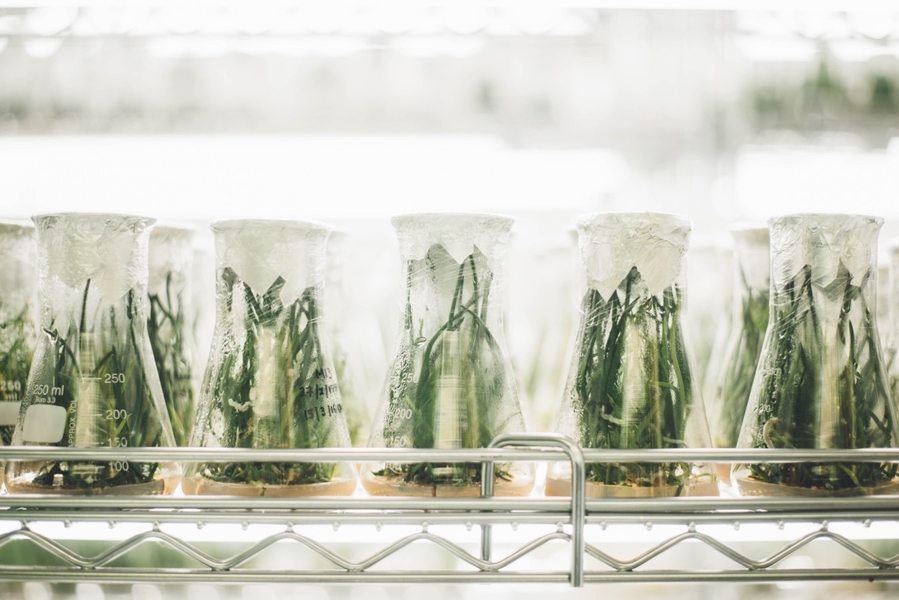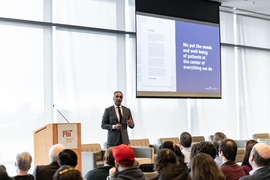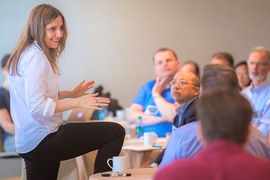In addition to offering a diverse roster of non-degree open-enrollment courses for individuals, MIT Sloan Executive Education commonly works with companies and organizations to design and deliver custom educational programs that address their specific challenges, leading to a dynamic learning experience that can yield significant, real-world results. MIT Sloan Executive Education embraces groups that view lifetime learning by their employees as a strategic investment and a source of competitive advantage.
One such collaboration involved Bayer AG, which recently approached MIT Sloan Executive Education with an opportunity to help Bayer develop a new capability across the company's entire global operation.
In early 2017, the executive leadership at Bayer R&D recognized that advancing digital innovation had to start with the wealth of talent within its diverse R&D community of 16,000 experts spanning three businesses (Pharmaceuticals, Crop Science, and Consumer Health), multiple scientific and technological domains, geographies, and cultures. Tapping into this potential required "digital intrapreneurs" — both life scientists and data scientists — who would take the initiative to pursue their novel data-driven ideas from concept to implementation.
The firm's corporate innovation team took on the challenge and designed R&D Tech Immersion, an intense three-year education experience, accelerating more than 20 projects across Bayer's R&D value chain, securing millions of Euros in funding of these projects beyond the program, and training about 100 participants from across R&D who amplified the learning throughout the company.
“Early into the design and planning phase, we decided that all technological content would be delivered by in-house data experts whom we mentored to become trainers,” says Alon Harris, a spokesperson for science and sustainability within Bayer R&D, and one of the primary architects of the program. “However, when it came to the entrepreneurship and innovation leadership components, we decided to work with a world-class leader in executive education and found our ideal partner in MIT Sloan Executive Education.”
MIT Sloan Senior Lecturer Court Chilton saw an opportunity to help Bayer build a new capability in data science with learning modules developed at MIT. “A capability is a combination of a mindset, a set of tools, and processes. It’s a distinctive strength you use to operate the business,” he explains. “Bayer wanted more people in R&D to have this new core capability and there was no way to stretch the few smart data scientists at that scale. So instead of having a few smart people in the data science function, they have many more people familiar with the kinds of problems data science can/can’t solve, and enough knowledge to frame those problems, ask the right questions, and evaluate results.”
Twenty-five training days were spread over the course of six-to-eight months, culminating in an intense week at MIT Sloan School of Management, which was filled with inspiring yet practical lectures, exercises, and meetings with MIT faculty leading groundbreaking innovation in the AI and life sciences.
Chilton, the faculty and program director of the MIT learning modules, notes: “Most organizations say, ‘Just go to MIT, listen, and do what they teach you,’ but not Bayer! The corporate R&D training team was involved in every step of the design and delivery of the program. And because of this close relationship, we were able to co-create a solution that embedded frameworks we teach such as design thinking, human-centered design, leadership frameworks. The program evolved significantly from year to year, so we had to be flexible, experiment, and devise creative approaches, which was very much in the spirit of the program experience.”
Putting trust in your people
“We chose people who we saw as having the right mindset and perspective and, inevitably, many of them by now have grown to new, senior roles, leading departments or digital initiatives around the company,” points out Michael Devoy, Bayer Pharma's chief medical officer, executive vice president of medical affairs and pharmacovigilance, and an active executive sponsor and champion of this program. “The program seeded that into wider parts of our organization, and in addition it led to people building up links inside but also outside Bayer with developing new partnerships and relationships.”
Devoy underscores an important early decision in participant selection: “Usually if we would send executives to MIT, they would be more senior people in the organization, already in their mid-career or later. And the interesting thing here was that we took people relatively early in their careers who are very practically motivated, exposed them to a top-class institution, and then saw the growth they’ve experienced. I saw a sort of synergy between those two aspects.”
Creating space for personal transformation
Kirsten Skogerson is the Competitor Intelligence team lead at Bayer U.S. Crop Science Division. She participated in the third cohort and described her experience as one she would never forget because it had changed the way she thinks now.
“This really came from the MIT portion of the program, this idea that digital transformation is not just about technology, but about leadership capabilities and managing change. And it fundamentally changed the way I thought about digital transformation and made me realize that I could play an important role and a bigger role than I had originally thought at Bayer,” Skogerson says. “I could enact the behaviors we learned about at MIT that are needed for success within the organization.”
Based in Berlin, Angelo Ziletti is a principal data scientist in a group responsible for decision science in medical affairs, pharmacovigilance, and regulatory affairs. Ziletti says the program inspired him to use what he learned and apply it in everyday work situations. He found it especially valuable to have an opportunity to hone soft social skills like patience and empathy, which he sees as essential in solving problems in a collaborative manner with people who may not have expertise in the same area, but whose own expertise is just as crucial to finding a solution together.
“At MIT, the great professors were encouraging us to drive digital transformation. And it’s hard to apply that 100 percent, but you should always strive toward that,” Ziletti shares. “I realized that we data scientists were just as responsible for leading the transformation in the company as were the business people and senior executives.”
Build connections among people and across disciplines
Jason Lott, vice president of integrated evidence generation, specialty medicine, integrated care, and cell and gene therapy at Bayer Pharmaceuticals, describes his experience as a participant as “by far the most fun thing I’ve done and the most transformative since I’ve been at Bayer. It was great!” He went on to elaborate: “These frameworks of experimentation and innovation, and the framework of approaching the ‘problem space’ versus the framework of approaching the ‘solution space,’ and thinking from the business, end-user, desirability, usability perspective was very new to me and it was very impressive. Understanding how data science interdigitates with these types of frameworks was all new to me. It left a big mark on my own thinking.”
Senior Vice President Monika Lessl, head of corporate R&D, social innovation, and the Bayer Foundation, was one of the program’s key sponsors. “Building a cross-disciplinary network of change agents was a key objective of this program,” she notes. “It was not only about bringing these people together to learn and then each go their separate ways. We intentionally nurtured this network after the program and fostered collaboration. It’s absolutely important to keep that connection.”
Invest in solving real-life business challenges
The capstone of the program was a unique opportunity for the participants to directly engage their R&D executives and pitch project proposals, advocating for transforming their ideas into real and funded, digital innovation projects embedded into the respective digital pipelines.
“The challenges we addressed spanned a broad array of unmet needs and ‘jobs to be done’,” explains Alon Harris. “Some challenges were directly related to our core business: the discovery of new small molecules, antibodies, and biomarkers. Other challenges focused on operational excellence: accelerating the development of non-prescriptive products by forecasting stability, rapidly dealing with the worldwide changes in product labeling requirements, minimizing cumbersome manual tasks when compiling regulatory reports. The third class of challenges related to inventing new value propositions and new business models, such as finding new ways to leverage wearables and provide customers with hyper-tailored product recommendations.
“It wasn’t just something that you would do in the program and then everyone says how nice it is and goes back to their daily work,” emphasizes Devoy. “Quite a lot of these projects continued in a practical way or were implemented within the normal Bayer business.”
Adds Harris: “Toward the final phase of the program, and thanks to the outstanding MIT Sloan faculty, we were able to equip our cohorts with practical frameworks and tools for driving digital transformation on a strategic level, enabling cultural change, strategizing around tech-driven disruption, and developing their personal style of innovation leadership.”
He cautions business leaders not to “lose sight of the immense potential of your own employees to become entrepreneurs and drive innovation. This requires time, resources, and patience, and there are no shortcuts. Yet as our experience over the years has shown us: when done properly, cultivating this spirit internally has the potential to bear amazing results — for the business, for the organizational culture, and for all the individuals who have grown into innovation leaders in the process.”









